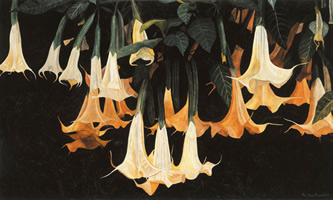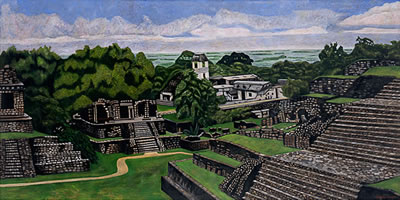Leo Rosas
Take the Light and Reflect It When you see him approaching you can tell that he is an artist. His appearance, his expression, And Pedro Diego Alvarado is a painter who refused to paint. Initially he focused his artistic search toward photography. He hid behind the lens and developed his vision of the world in black and white. However, one day he discovered that a great photographer, Cartier-Bresson, set the camera aside and began to draw. “I too began to draw and took my first step toward painting,” he states with conviction.
After his European experience, where he managed to exhibit in Remes and in Paris, he returned to Mexico, and by 1980, was presenting his first solo exhibit at the gallery of Lourdes Chumacero while also working on landscapes of Guanajuato under the guiding eye of master painter Jesús Gallardo. His continual search for learning did not stop there. He felt the need to keep on searching for new enriching horizons. So, he painted at the workshop of Ricardo Martinez and learned metal engraving with Mario Reyes. More solo exhibitions followed and more searching. Always seeking out beauty, he set up house in Tepoztlán. About his home he says: “I just felt good there. It’s a fantastic place, very close to Mexico City, where you can come and go in the same day, and like all the spiritual places in the world, Tepoztlán is sacred”. It is a goldmine for inspirations to be placed on canvases. His still lifes (of which the renown art critic Oliver Debroisse declares: “Pedro Diego picks up still lifes at the moment where Cézanne left them”) flow one after the other and his Mexican landscapes exalt the color of the nation. Despite his youth and the era he got to live in, this painter cannot escape from his fascination for muralism. In 1989, he painted a His most recent work met with great success in 1993 at the Galería de Arte Mexicano where he presented 28 canvases worked in tempera and oil, in which he recreated his house, his garden and his studio. He states that he wants to recuperate the craft of painting that, unfortunately, is being lost. “Which is I want to return to the source and retrieve the centuries of painting that precede us”. Here, in the interview room of Casas & Gente we spoke with Pedro Diego de Alvarado, grandson of the great Diego (Rivera), about his immediate plans, since he is now one of a group of artistic creators to have received a three-year grant from the National System of Artistic Creators. Controversy surrounding the bestowal of grants to the “big wheels” of art does not seem to bother Pedro, who does not belong to that group himself. He belongs instead to a group of young artists (38 years old) who still have a long road ahead of them. His response is straightforward: “I’m going to England to work alongside the painter Armando Morales, a Nicaraguan, one of Latin Americas most important and recognized artists in the world. Although Mexico is a very generous with its artists and there are many talented painters, in Europe, another level of aperture, of markets, of competitiveness is sought; it’s important to be recognized over there”, Pedro Diego says in a thoughtful tone and continues: We should experiment and move forward. Which is why in 1994 I plan to continue working in the style of the renaissance, and taking up the craft of the masters and his students. Linking painting to its furthermost roots is essential. Capture the light and reflect it”. His most recent work, on display at the Galería de Arte Mexicano by the end of 1993, will travel to Tijuana and from then begin a tour throughout Mexico. “That way I won’t be entirely absent”. Casas & Gente |
|

 his penetrating gaze are an indication that we are faced with one of those sensitive souls, calm on the outside and tormented on the inside. Those who throw their emotions and their conception of the world on to the poet’s blank page or a painter’s canvas.
his penetrating gaze are an indication that we are faced with one of those sensitive souls, calm on the outside and tormented on the inside. Those who throw their emotions and their conception of the world on to the poet’s blank page or a painter’s canvas. He was only 18 years old, in 1974, when he entered the Escuela Nacional de Pintura La Esmeralda, before following up his studies in the Academia de San Carlos with master painter Gilberto Aceves Navarro. And, as usual, the artist’s eternal dream of Paris called to him from the other side of the ocean and there he went. During 1977 and 1978, he sketched and painted close to Henri Cartier-Bresson, Jacques Hartmann and Gerard Barthelemy. He also learned lithography.
He was only 18 years old, in 1974, when he entered the Escuela Nacional de Pintura La Esmeralda, before following up his studies in the Academia de San Carlos with master painter Gilberto Aceves Navarro. And, as usual, the artist’s eternal dream of Paris called to him from the other side of the ocean and there he went. During 1977 and 1978, he sketched and painted close to Henri Cartier-Bresson, Jacques Hartmann and Gerard Barthelemy. He also learned lithography. 60 square meter mural at the Amparo Museum in Puebla (Mexico) for which he studied the Venetian style with the artist Vlady. Again, trips to France and Spain followed, distancing him from the native soil to which he always returns. In 1992, he dedicated himself in-depth to serigraphy at the workshop of José González Casanova.
60 square meter mural at the Amparo Museum in Puebla (Mexico) for which he studied the Venetian style with the artist Vlady. Again, trips to France and Spain followed, distancing him from the native soil to which he always returns. In 1992, he dedicated himself in-depth to serigraphy at the workshop of José González Casanova. “We are the end of the twentieth century and it is time to recover the craft, the know-how. Great painters such as Picasso and Matisse did the same at the end of the nineteenth century. Then came that avalanche of Modern Art that moved away from the “abc´s” and now its time to salvage those essential rudiments in order to also reclaim the freedom. For today’s painters, the end of the century marks an era of change that appeals to our creativity to know what to do. It’s not a matter of going back. That’s impossible!”
“We are the end of the twentieth century and it is time to recover the craft, the know-how. Great painters such as Picasso and Matisse did the same at the end of the nineteenth century. Then came that avalanche of Modern Art that moved away from the “abc´s” and now its time to salvage those essential rudiments in order to also reclaim the freedom. For today’s painters, the end of the century marks an era of change that appeals to our creativity to know what to do. It’s not a matter of going back. That’s impossible!”